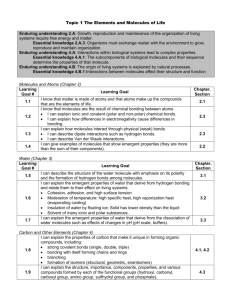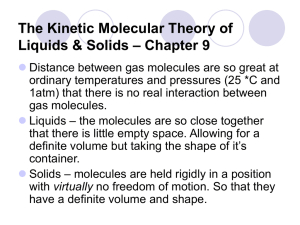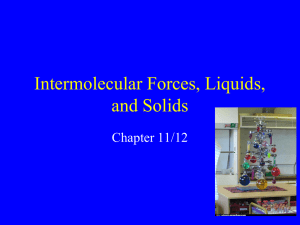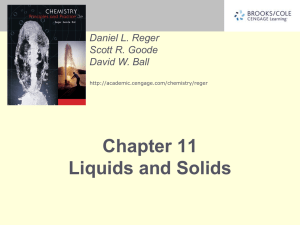Unit 10 UBD Enduring Understandings. Enduring Understanding 2
advertisement
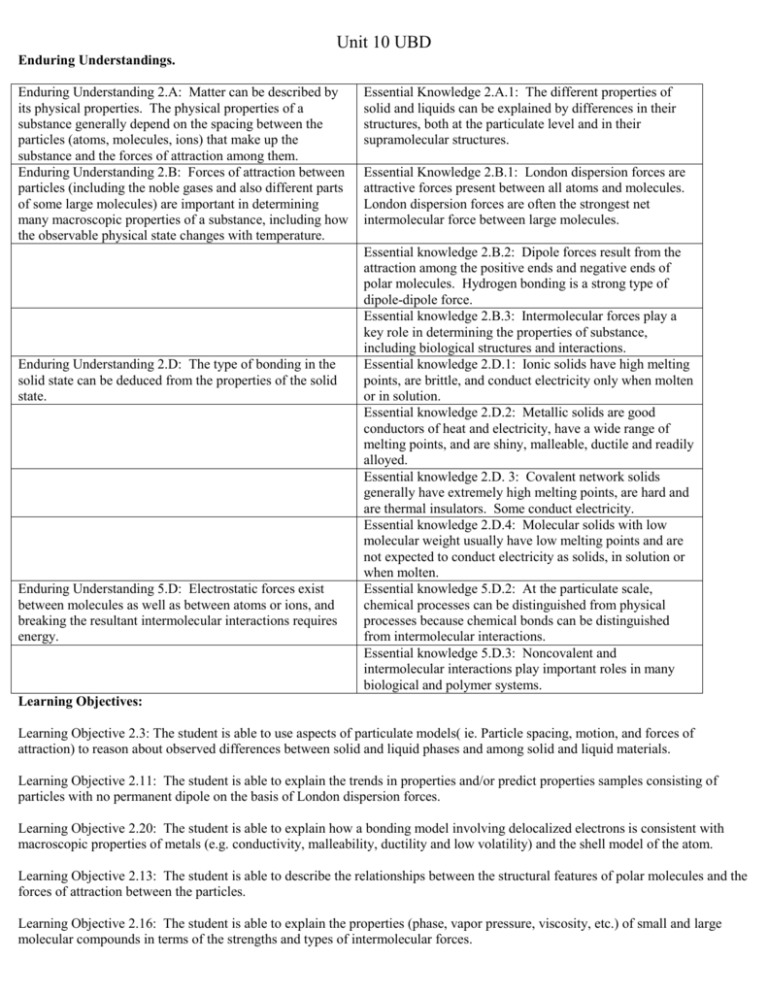
Unit 10 UBD Enduring Understandings. Enduring Understanding 2.A: Matter can be described by its physical properties. The physical properties of a substance generally depend on the spacing between the particles (atoms, molecules, ions) that make up the substance and the forces of attraction among them. Enduring Understanding 2.B: Forces of attraction between particles (including the noble gases and also different parts of some large molecules) are important in determining many macroscopic properties of a substance, including how the observable physical state changes with temperature. Enduring Understanding 2.D: The type of bonding in the solid state can be deduced from the properties of the solid state. Enduring Understanding 5.D: Electrostatic forces exist between molecules as well as between atoms or ions, and breaking the resultant intermolecular interactions requires energy. Essential Knowledge 2.A.1: The different properties of solid and liquids can be explained by differences in their structures, both at the particulate level and in their supramolecular structures. Essential Knowledge 2.B.1: London dispersion forces are attractive forces present between all atoms and molecules. London dispersion forces are often the strongest net intermolecular force between large molecules. Essential knowledge 2.B.2: Dipole forces result from the attraction among the positive ends and negative ends of polar molecules. Hydrogen bonding is a strong type of dipole-dipole force. Essential knowledge 2.B.3: Intermolecular forces play a key role in determining the properties of substance, including biological structures and interactions. Essential knowledge 2.D.1: Ionic solids have high melting points, are brittle, and conduct electricity only when molten or in solution. Essential knowledge 2.D.2: Metallic solids are good conductors of heat and electricity, have a wide range of melting points, and are shiny, malleable, ductile and readily alloyed. Essential knowledge 2.D. 3: Covalent network solids generally have extremely high melting points, are hard and are thermal insulators. Some conduct electricity. Essential knowledge 2.D.4: Molecular solids with low molecular weight usually have low melting points and are not expected to conduct electricity as solids, in solution or when molten. Essential knowledge 5.D.2: At the particulate scale, chemical processes can be distinguished from physical processes because chemical bonds can be distinguished from intermolecular interactions. Essential knowledge 5.D.3: Noncovalent and intermolecular interactions play important roles in many biological and polymer systems. Learning Objectives: Learning Objective 2.3: The student is able to use aspects of particulate models( ie. Particle spacing, motion, and forces of attraction) to reason about observed differences between solid and liquid phases and among solid and liquid materials. Learning Objective 2.11: The student is able to explain the trends in properties and/or predict properties samples consisting of particles with no permanent dipole on the basis of London dispersion forces. Learning Objective 2.20: The student is able to explain how a bonding model involving delocalized electrons is consistent with macroscopic properties of metals (e.g. conductivity, malleability, ductility and low volatility) and the shell model of the atom. Learning Objective 2.13: The student is able to describe the relationships between the structural features of polar molecules and the forces of attraction between the particles. Learning Objective 2.16: The student is able to explain the properties (phase, vapor pressure, viscosity, etc.) of small and large molecular compounds in terms of the strengths and types of intermolecular forces. Learning Objective 2.22 the student is able to design or evaluate a plan to collect and/or interpret data needed to deduce the type of bonding in a sample of a solid. Learning Objective 2.23 The student can create a representation of an ionic solid that shows essential characteristics of the structure and interactions present in the substance. Learning Objective 2.24 The student is able to explain a representation that connects properties of an ionic solid to its structural attributes and to the interactions present at the atomic level. Learning Objective 2.25 The student is able to compare the properties of metal alloys with their constituent elements to determine if an alloy has formed, identify the type of alloy formed, and explain the differences in properties using particulate level reasoning. Learning Objective 2.26 Students can use the electron sea model of metallic bonding to predict or make claims about the macroscopic properties of metals or alloys. Learning Objective 2.27 The student can create a representation of a metallic solid that shows essential characteristics of the structure and interactions present in the substance. Learning Objective 2.28 The student is able to explain a representation that connects properties of a metallic solid to its structural attributes and to the interactions present at the atomic level. Learning Objective 2.29 The student can create a representation of a covalent solid that shows essential characteristics of the structure and interactions present in the substance. Learning Objective 2.30 The student is able to explain a representation that connects properties of a covalent solid to its structural attributes and to the interactions present at the atomic level. Learning Objective 2.31 The student can create a representation of a molecular solid that show essential characteristics of the structure and interactions present in the substance. Learning Objective 2.32 The student is able to explain a representation that connects properties of a molecular solid to its structural attributes and to the interactions present the atomic level. Learning Objective 3.10 The student is able to evaluate the classification of a process as a physical change, chemical change, or ambiguous change based on both macroscopic observations and the distinction between rearrangement of covalent interactions and noncovalent interactions. Learning Objective 5.1 The student is able to create or use graphical representations in order to connect the dependence of potential energy to the distance between atoms and factors, such as bond order (for covalent interactions) and polarity ( for intermolecular interactions), which influence the interaction strength. Learning Objective 5.9 The student is able to make claims and/or predictions regarding relative magnitudes of the forces acting within collections of interacting molecules abased on the distribution of electrons within the molecules an the types of intermolecular forces through which the molecules Learning Objective 5.10 The student can support the claim about whether a process is a chemical or physical change ( or may be classified as both) based on whether the process involves changes in intramolecular versus intermolecular interactions. Learning Objective 5.11 The student is able to identify the noncovalent interactions within and between large molecules, and/or connect the shape and function of the large molecule to the presence and magnitude of these interactions. Teaching Points 1. Solids can be crystalline, where the particles are arranged in a regular 3-D structure, or they can be amorphous, where the particles do not have a regular, orderly arrangement. In both cases, the motion of the individual particles is limited, and the particles do not undergo any overall translation with respect to each other. Interparticle interactions and the ability to pack the particles together provide the main criteria for the structures of solids. 2. The constituent particles in liquids are very close to each other, and they are continually moving and colliding. The particles are able to undergo translation with respect to each other and their arrangement, and movement is influenced by the nature and strength of the intermolecular forces that are present. 3. The solid and liquid phases for a particular substance generally have relatively small differences in molar volume because in both cases the constituent particles are very close to each other at all times. 4. The differences in other properties, such as viscosity, surface tension, and volumes of mixing (for liquids), and hardness and macroscopic crystal structure (for solids), can be explained by differences in the strength of attraction between the particles and/or their overall organization. 5. Heating and cooling curves for pure substances provide insight into the energetics of liquid/solid phase changes. 6. Forces of attraction between particles (including the noble gases and also different parts of some large molecules) are important in determining many macroscopic properties of a substance, including how the observable physical state changes with temperature. 7. Chemists categorize intermolecular interactions based on the structural features giving rise to the interaction. Although there are some trends in the relative strengths of these interactions, the specific structure and size of the particles involved can play a very important role in determining the overall strength of a particular intermolecular (or intramolecular) interaction. The properties of condensed phases and of manycrucial biological structures are determined by the nature and strength of these interactions. Deviation from ideal gas behavior is generally a reflection of the presence of intermolecular interactions between gas particles. Thus, in all phases, the structure of particles on the molecular level is directly related to the properties of both the particles themselves and the behavior of macroscopic collections of those molecules. 8. London dispersion forces are attractive forces present between all atoms and molecules. London dispersion forces are often the strongest net intermolecular force between large molecules. a. A temporary, instantaneous dipole may be created by an uneven distribution of electrons around the nucleus (nuclei) of an atom (molecule). b. London dispersion forces arise due to the Coulombic interaction of the temporary dipole with the electron distribution in neighboring atoms and molecules. c. Dispersion forces increase with contact area between molecules and with increasing polarizability of the molecules. The polarizability of a molecule increases with the number of electrons in the molecule, and is enhanced by the presence of pi bonding. 9. Dipole forces result from the attraction among the positive ends and negative ends of polar molecules. 10. 10. Hydrogen bonding is a strong type of dipole-dipole force. a. Molecules with dipole moments experience Coulombic interactions that result in a net attractive interaction when they are near each other. 1. Intermolecular dipole-dipole forces are weaker than ionic forces or covalent bonds. 2. Interactions between polar molecules are typically greater than between nonpolar molecules of comparable size because these interactions act in addition to London dispersion forces. 11. Dipole-dipole attractions can be represented by diagrams of attraction between the positive and negative ends of polar molecules trying to maximize attractions and minimize repulsions in the liquid or solid state. 12. Dipole-induced dipole interactions are present between a polar and nonpolar molecule. The strength of these forces increases with the magnitude of the dipole of the polar molecule and with the polarizability of the nonpolar molecule. 13. Hydrogen bonding is a relatively strong type of intermolecular interaction that occurs when hydrogen atoms that are covalently bonded to the highly electronegative atoms (N, O, and F) are also attracted to the negative end of a dipole formed by the electronegative atom (N, O, and F) in a different molecule, or a different part of the same molecule. When hydrogen bonding is present, even small molecules may have strong intermolecular attractions. 14. Hydrogen bonding between molecules, or between different parts of a single molecule, may be represented by diagrams of molecules with hydrogen bonding and indications of location of hydrogen bonding. 15. Ionic interactions with dipoles are important in the solubility of ionic compounds in polar solvents. 16. Intermolecular forces play a key role in determining the properties of substances, including biological structure sand interactions. 17. Many properties of liquids and solids are determined by the strengths and types of intermolecular forces present. a. Boiling point b. Surface tension c. Capillary action d. Vapor pressure 18. Substances with similar intermolecular interactions tend to be miscible or soluble in one another. 19. The presence of intermolecular forces among gaseous particles, including noble gases, leads to deviations from ideal behavior, and it can lead to condensation at sufficiently low temperatures and/or sufficiently high pressures. 20. Graphs of the pressure-volume relationship for real gases can demonstrate the deviation from ideal behavior; these deviations can be interpreted in terms of the presence and strengths of intermolecular forces. 21. The structure and function of many biological systems depend on the strength and nature of the various Coulombic forces. 1. Substrate interactions with the active sites in enzyme catalysis 2. Hydrophilic and hydrophobic regions in proteins that determine three dimensional structure in water solutions. 22. The type of bonding in the solid state can be deduced from the properties of the solid state. In solids, the properties of the material reflect the nature and strength of the interactions between the constituent particles. For this reason, the type of bonding that predominates in a solid material, and the nature of the interactions between the particles comprising the solid, can generally be inferred from the observed macroscopic properties of the material. Properties such as vapor pressure, conductivity as a solid and in aqueous solution, and relative brittleness or hardness can generally be explained in this way. Although recognizing the properties that can be associated with a particular type of bonding is valuable in categorizing materials, relating those properties to the structure of the materials on the molecular scale, and being able to make reasoned predictions of the properties of a solid based on its constituent particles, provides evidence of deeper conceptual understanding. 23. Ionic solids have high melting points, are brittle, and conduct electricity only when molten or in solution. a. Many properties of ionic solids are related to their structure. 1. Ionic solids generally have low vapor pressure due to the strong Coulombic interactions of positive and negative ions arranged in a regular three dimensional array. 2. Ionic solids tend to be brittle due to the repulsion of like charges caused when one layer slides across another layer. 3. Ionic solids do not conduct electricity. However, when ionic solids are melted, they do conduct electricity because the ions are free to move. 4. When ionic solids are dissolved in water, the separated ions are free to move; therefore, these solutions will conduct electricity. Dissolving a nonconducting solid in water, and observing the solution’s ability to conduct electricity, is one way to identify an ionic solid. 5. Ionic compounds tend not to dissolve in nonpolar solvents because the attractions among the ions are much stronger than the attractions among the separated ions and the nonpolar solvent molecules. a. The attractive force between any two ions is governed by Coulomb’s Law: The force is directly proportional to the charge of each ion and inversely proportional to the square of the distance between the centers of the ions. 1. For ions of a given charge, the smaller the ions, and thus the smaller the distance between ion centers, the stronger the Coulombic force of attraction, and the higher the melting point. 2. Ions with higher charges lead to higher Coulombic forces, and therefore higher melting points. 6. Metallic solids are good conductors of heat and electricity, have a wide range of melting points, and are shiny, malleable, ductile, and readily alloyed. a. A metallic solid can be represented as positive kernels (or cores) consisting of the nucleus and inner electrons of each atom surrounded by a sea of mobile valence electrons. 1. Metals are good conductors because the electrons are delocalized and relatively free to move. 2. Metals are malleable and ductile because deforming the solid does not change the environment immediately surrounding each metal core. b. Metallic solids are often pure substances, but may also be mixtures called alloys. 1. Some properties of alloys can be understood in terms of the size of the component atoms: — Interstitial alloys form between atoms of different radius, where the smaller atoms fill the interstitial spaces between the larger atoms. (Steel is an example in which carbon occupies the interstices in iron.) The interstitial atoms do not appreciably expand the lattice, so the density is often substantially increased. The interstitial atoms make the lattice more rigid, decreasing malleability and ductility. — Substitutional alloys form between atoms of comparable radius, where one atom substitutes for the other in the lattice. (Brass is an example in which some copper atoms are substituted with a different element, usually zinc.) The density typically lies between those of the component metals, and the alloy remains malleable and ductile. 2. Alloys typically retain a sea of mobile electrons and so remain conducting. 3. In some cases, alloy formation alters the chemistry of the surface. An example is formation of a chemically inert oxide layer in stainless steel. 23. Covalent network solids generally have extremely high melting points, are hard, and are thermal insulators. Some conduct electricity. a. Covalent network solids consist of atoms that are covalently bonded together into a two-dimensional dimensional network. 1. Covalent network solids are only formed from nonmetals: elemental (diamond, graphite) or two nonmetals (silicon dioxide and silicon carbide). or three- 2. The properties of covalent network solids are a reflection of their structure. 3. Covalent network solids have high melting points because all of the atoms are covalently bonded. 4. Three-dimensional covalent networks tend to be rigid and hard because the covalent bond angles are fixed. 5. Generally, covalent network solids form in the carbon group because of their ability to form four covalent bonds. a. Graphite is an allotrope of carbon that forms sheets of two-dimensional networks. 1. Graphite has a high melting point because the covalent bonds between the carbon atoms making up each layer are relatively strong. 2. Graphite is soft because adjacent layers can slide past each other relatively easily; the major forces of attraction between the layers are London dispersion forces. b. Silicon is a covalent network solid and a semiconductor. 1. Silicon forms a three-dimensional network similar in geometry to a diamond. 2. Silicon’s conductivity increases as temperature increases. 3. Periodicity can be used to understand why doping with an element with one extra valence electron converts silicon into an n-type semiconducting (negative charge carrying) material, while doping with an element with one less valence electron converts silicon into a p-type semiconducting (positive charge carrying) material. Junctions between n-doped and p-doped materials can be used to control electron flow, and thereby are the basis of modern electronics. 24. Molecular solids with low molecular weight usually have low melting points and are not expected to conduct electricity as solids, in solution, or when molten. a. Molecular solids consist of nonmetals, diatomic elements, or compounds formed from two or more nonmetals. b. Molecular solids are composed of distinct, individual units of covalently bonded molecules attracted to each other through relatively weak intermolecular forces. 1. Molecular solids are not expected to conduct electricity because their electrons are tightly held within the covalent bonds of each constituent molecule. 2. Molecular solids generally have a low melting point because of the relatively weak intermolecular forces present between the molecules. 3. Molecular solids are sometimes composed of very large molecules, or polymers, with important commercial and biological applications. 25. The student is able to create or use graphical representations in order to connect the dependence of potential energy to the distance between atoms and factors, such as polarity (for intermolecular interactions), which influence the interaction strength. 26. Potential energy is associated with the interaction of molecules; as molecules draw near each other, they experience an attractive force. a. Chemists categorize intermolecular forces in terms of the nature of the charge distributions in the molecules involved. Thus, dipole-dipole, dipole-induced dipole, and induced dipole-induced dipole (dispersion) can be defined. b. All substances will manifest dispersion forces, and these forces tend to be larger when the molecules involved have more electrons or have a larger surface area. c. Hydrogen bonding is a relatively strong type of intermolecular interaction that occurs when hydrogen atoms that are covalently bonded to the highly electronegative atoms (N, O, and F) are also attracted to the negative end of a dipole formed by the electronegative atom (N, O, and F) in a different molecule, or a different part of the same molecule. When hydrogen bonding is present, even small molecules may strong intermolecular forces. 27. Noncovalent and intermolecular interactions play important roles in many biological and polymer systems. a. In large biomolecules, noncovalent interactions may occur between different molecules or between different regions of the same large biomolecule. b. The functionality and properties of molecules depend strongly on the shape of the molecule, which is largely dictated by noncovalent interactions. For example, the function of enzymes is dictated by their structure, and properties of synthetic polymers are modified by manipulating their chemical composition and structure.





